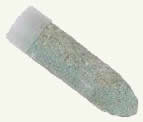Many homeowners recognize the value of fertilizing trees and shrubs in their landscapes, yet they become confused when confronted with the variety of fertilizers available to them. Also confusing can be directions that give application rates in pounds of nutrient per acre when only one tree is to be fertilized.
For many people fertilizer calculations are difficult to perform and even prevent them from applying fertilizers.

Figure 1 - Fertilizer spike
Development of compressed fertilizer spikes, as shown in Figure 1, tablets and briquettes has been attractive to these gardeners because it simplifies the process. A pre-measured amount of fertilizer is formed into a larger dispensing unit that can be applied according to homeowner's directions on a "so many per plant" or "so many per a certain number of square feet" basis.
It should be noted that fertilizer spikes are available in organic formulas.
What consumers need to be aware of is the trade off in increased price when using convenience fertilizers. While convenience fertilizers are easier and less time consuming to apply, the same amount of fertilizer is almost always less expensive if purchased in bulk as a granular material.
In a survey of local garden centers, one of the best known convenience fertilizers is selling for an average of $4.50 for 5 spikes or $10.00 for 12 spikes, a range of $0.83 to $0.90 per spike. Based on the 16-8-8 fertilizer analysis given on the package, and the fact that each spike weighs approximately 5.2 ounces, the 0.8 ounce of nitrogen per spike makes the cost of the actual nitrogen approximately $1.13 per ounce or $18.00 per pound.
By comparison, an ounce of actual nitrogen from the common granular fertilizer 10-10-10 (based on an average price of $9.00 for a 50 pound bag) costs approximately $0.11 per ounce or $1.75 per pound. Based on these prices a consumer pays a price ten times higher for the same amount of nitrogen fertilizer when buying the spike's convenience.
A generic spike from a bulk bin selling for $0.29 per spike had a 15-7-6 analysis and a spike weight of approximately 4 ounces. This equates to an actual nitrogen cost of approximately $0.48 per ounce or approximately $7.75 per pound. This spike costs less than half the name brand spike but still over four times more than the granular fertilizer.
Recent studies have shown that plant roots typically extend far beyond the drip-line. Since most of these roots are fine feeder roots that absorb water and nutrients for the plant, fertilization should not be confined within the drip-line. The "two inch below soil level" recommended for spikes would place them right in the major area of root concentration.
Broadcasting fertilizer on the soil surface under trees and shrubs has been shown to be as effective as deeper placement. Though grass roots do get a large portion of the fertilizer, there generally is an adequate amount left for trees.
If a homeowner routinely tests the soil and applies the amount of fertilizer needed for good grass growth, additional fertilizer for trees and shrubs growing in the lawn is probably unnecessary and would be considered luxury feeding where the plants may absorb and store extra fertilizer, but produce no appreciably extra growth because of it.
It should be noted that if a soil test shows that additional phosphorus (P) and potassium (K) are not needed, money is wasted if a spike or any other type of fertilizer with a complete analysis is used.
Spike products do offer some additional advantages that may compensate for cost to some gardeners. They are a form of controlled or slow release fertilizer. Small amounts of fertilizer are available to the plant at any one time so that no burning occurs. In addition, slow metering means that fertilizer is not leached away or wasted. Enough fertilizer is contained in each spike that using the number recommended gives slow, even feeding for a full year.
A new type of spike has recently been introduced that contains a systemic insecticide in addition to the above mentioned slow release fertilizer. The spikes can feed and protect plants against insects such as bagworms and aphids if used in the number and with the frequency recommended on the package. There are convenience and reduced waste benefits, but again, both the fertilizer and the insecticide costs more than if applied conventionally.
For people who would otherwise not fertilize or spray their trees and shrubs, spikes are an excellent product. For those who would, weigh cost against convenience and purchase accordingly.
